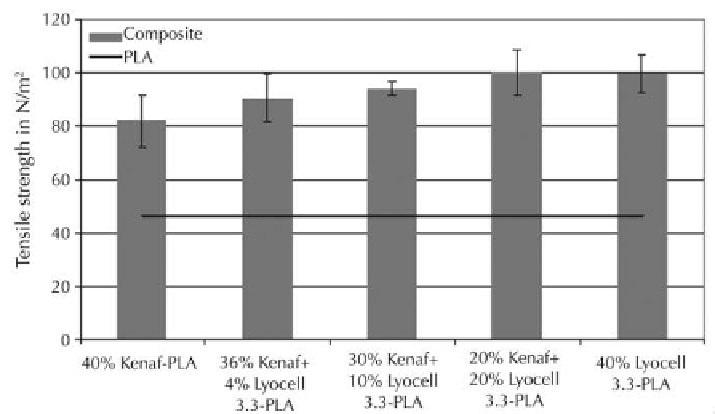Biomedical Engineering Reference
In-Depth Information
A similar trend was described by Mieck et al. (2000). They investigated the influ-
ence of the admixture of lyocell fibers with different fiber loads on the mechanical
characteristics of flax fiber reinforced PP composites. The impact strength values in-
creased with a rising fiber load ranging between 0 and 40 mass%. By the admixture of
40 mass% lyocell the impact characteristics could be nearly tripled.
Figure 13 shows the tensile characteristics of the composites. A significant (U-test,
α = 0.05) reinforcement by adding the fibers could be proved with regard to the pure
matrix shown as black line. A smal increase of the tensile strength with increasing
lyocell fiber load was measured. The differences between the 40% kenaf/PLA com-
posites and 20% kenaf + 20% lyocell 3.3/PLA composites were significant according
to a Weir test with α = 0.05. At the first view this looks a bit curious because the kenaf
fiber bundles have the higher tensile strength. But this effect could be based on the
higher specific surface of the finer lyocell fibers in comparison to the coarser kenaf
fiber bundles (Vetrotex, 1995; comparison for glass fibers).
Figure 13.
Tensile strength of kenaf, lyocell and mixed kenaf/lyocell fiber reinforced PLA composites
(mean value as column, standard deviation as error bars).
CoNClusioN
The investigations have shown a great reinforcement potential for cellulose fibers in
PLA matrices. The kind of semi-finished products as well as the composite production
parameters has a big influence on the mechanical composite characteristics. Results
proved a clear increase of the tensile strength by a modification of the process pa-
rameters up to values more than double as high (A pre-drying step was inserted for 2
hr at 105°C, the compression moulding time was reduced from 10 to 5 min and the
cooling was carried out in a cold press at 25°C for 3 min instead of 30 min at room
temperature).


Search WWH ::

Custom Search